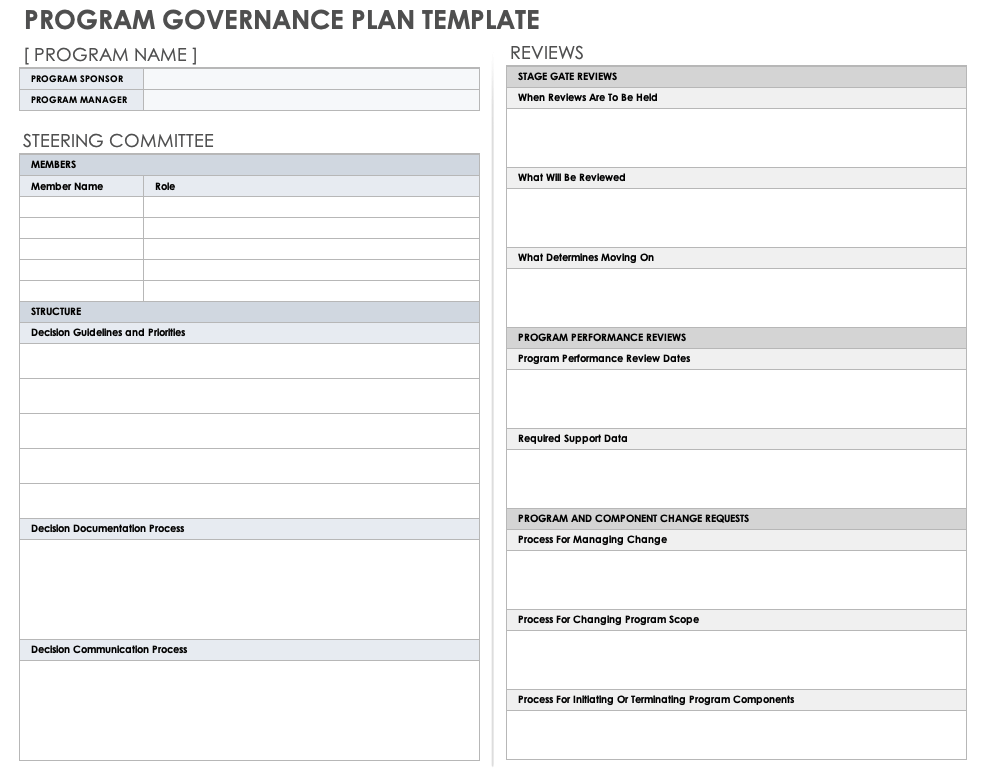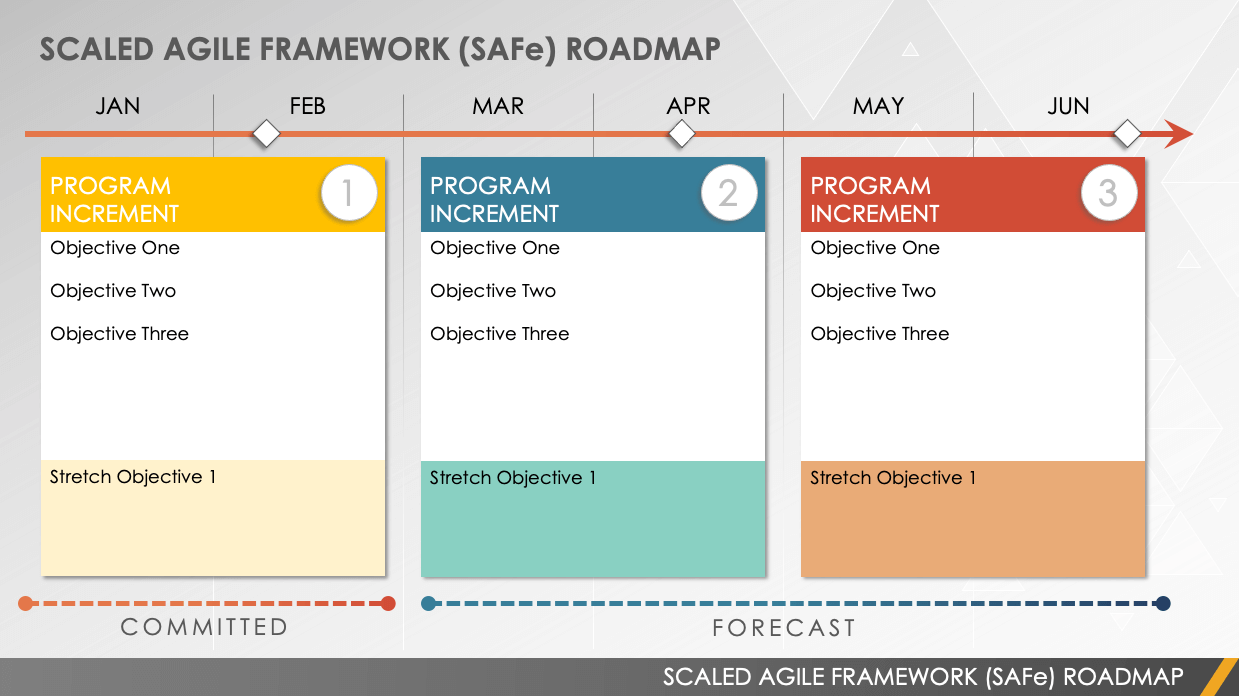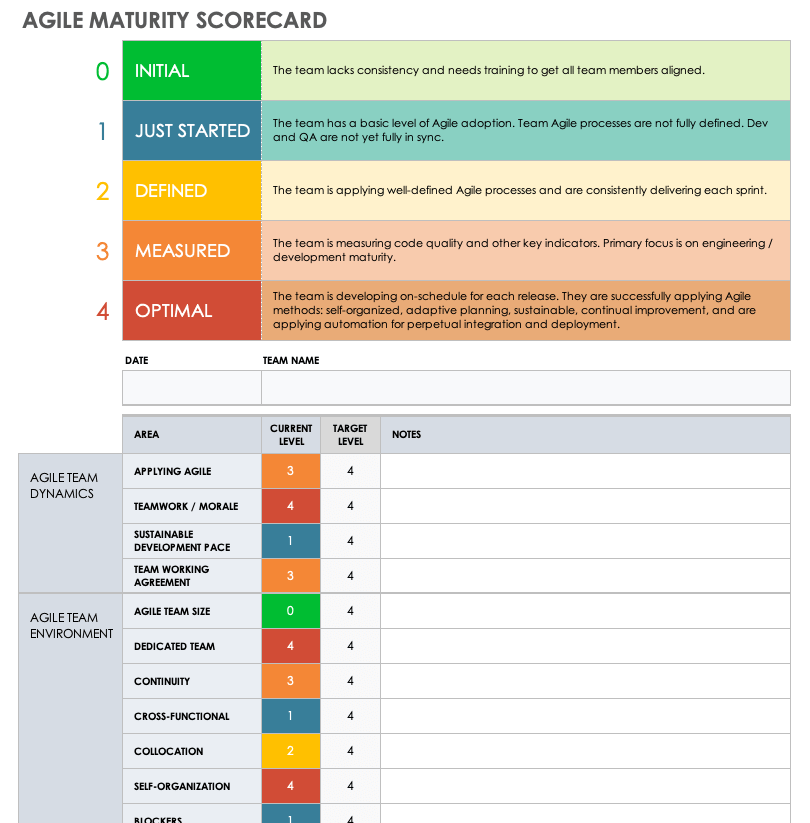What Is Agile Program Management?
Agile program management is the coordination of multiple, related Agile projects across an organization. The goal of Agile program management is to use Agile concepts to produce the best results for individual projects, while keeping overall business objectives in mind.
Traditional program management, as opposed to project management, does not focus on deliverables of individual projects, but on the progress and success of many related projects. In a small business, program managers might oversee projects across the entire company, while in a large enterprise, they might lead a single division.
Both Agile program management and traditional program management involve the coordination of teams working on similar projects and strive toward evolutionary and adaptive development of the final product. Agile program management, however, focuses on the Agile process and works to scale up the effort of Agile teams.
“When we talk about Agile program management, typically what people talk about, just from a label perspective, is scaling Agile, Agile at scale, or things like that,” says Alan Zucker, Founding Principal at Project Management Essentials. By implementing Agile best practices, program managers can coordinate and integrate multiple Agile projects to ensure program success.
Agile Program Management Governance
Organizations need to establish a cohesive governing structure to coordinate work in Agile program management. That structure will specify how teams collaborate on projects, make decisions, and determine standards and metrics for success, among other important managerial concerns.
Here are recommendations for establishing successful Agile program management governance:
- Ensure That Program Remains Aligned with Organizational Priorities: From the beginning, your program must align with your organization’s priorities. As work continues, it is vital that team leaders maintain that alignment and ensure work doesn’t veer into areas that don’t align with organizational goals.
- Allow for a Looser Structure Than Traditional Program Management: The Agile process works differently than traditional project management. Agile projects focus more on results than on process, so Agile program managers should avoid using traditional project management tactics that don’t align with Agile methodology.
- “What I want to influence rather than the structure is what we're focused on,” says Sarah Klarich, Principal at Dialexa, a Dallas-based digital product development consultancy. “I want people to focus on progress. Are we making progress? Do we have measurable results that we can make informed decisions on? We want to shift to progress and value away from on time and on budget. I can be on time and on budget and still not deliver what you need or what's going to be important for the organization. If I can shift the conversations, how you structure the governance is focused more on whether we are making the right decisions and whether we have the information to make them at the responsible time.”
- Shift Decisions to Lowest Level Possible: You want to make sure that the people making important decisions are the people who best understand the work. That means your organization should refrain from allowing only upper-level leaders to make decisions for the program.
“I want to shift those conversations,” says Klarich. “I'm still going to need the leaders to make decisions, but I also want to get them to shift responsibility down to the lowest level in the organization. I don't want every decision to have to go all the way up and go all the way back down. What decisions can teams make? What decisions can a project manager within your program make? What decisions can the program make without coming all the way up to an advisory council or a steering committee?” - Coordinate Across Multiple Teams: One of the most important objectives in Agile program management is ensuring that your organization successfully coordinates work across multiple Agile teams. Each team must know what other teams are doing, when they are scheduled to complete iterations, and where dependencies are among projects from various teams.
“There's a level of coordination across multiple teams that you might not have in a single project,” says Klarich, “so it's a little more complex in planning those value stream dependencies, aligning them, and coordinating them in a larger stakeholder group generally. It's multiple viewpoints coming together into prioritization. It's project management on steroids because you've got a scale factor to it.”
“Your Agile teams are doing pretty much the same thing that they're currently doing,” says Zucker. “They've got the product backlog, they're doing their planning, but imagine you've got a dozen teams. How do we coordinate the work across those dozen teams, so it's not just chaos?”
Zucker says that with traditional program management, “we do our big upfront planning. We parse out the work to all of our teams. They deliver. Then people finish at different times, and at the end, we integrate the work.”
Agile program management has to accommodate the differences in how Agile works, while accomplishing the same coordination of traditional program management. “We need to be synchronized so that we know what the priorities are,” says Zucker. “If the priorities on some Agile teams changed from two weeks ago to the next iteration or the next sprint, are we still coordinated on those changes? If we're developing in two-week cycles, it requires a lot more, and a lot closer, coordination.”
- Maintain Shorter Iterations: In Agile project management, managers divide work into shorter, two-week increments. Accordingly, in Agile program management, managers should divide work into shorter iterations than in traditional program management. Agile teams might get together to coordinate and analyze program progress every quarter or even every two months.
- “Incremental implies that components are taken in smaller segments, as in 8 to 12 weeks, maybe even stretch it to 15 to 16 weeks,” says Yad Senapathy, Founder and CEO of the Dallas-based Project Management Training Institute. “As opposed to running into six, seven, eight years, with some traditional program management, by trimming it down that way, it allows you to launch, plan, and execute programs in a complex environment, allowing the customer to get greater benefit.”
- Select Metrics and KPIs to Monitor and Manage Performance: As with Agile project management, you’ll want to decide on metrics and key performance indicators (KPIs) that can measure how your program is doing. Select a handful of important metrics, and continually monitor them. Be sure to select the best KPIs and metrics for your specific program.
SAFe: A Common Framework for Agile Program Management
A common framework used to scale Agile projects into Agile program management is the Scaled Agile Framework (SAFe). SAFe is a set of organizational structures that help teams and program managers implement Agile concepts for complex programs and portfolios.
When using SAFe practices, organizations can organize and coordinate various Agile teams working on similar projects. By doing so, program managers can ensure that their programs move forward as quickly as possible and deliver results that benefit the entire organization.
SAFe: Agile Release Train
A vital component of SAFe is the Agile Release Train (ART), a collection of several Agile teams that work on similar projects or products. These teams coordinate to track dependencies, align priorities, and ensure timely completion of all projects.
An Agile Release Train usually includes about 75 to 150 people working on separate but related projects. “SAFe coordinates the work of half a dozen to a dozen different teams into a program,” says Zucker.
SAFe and its Agile Release Trains are important on a complex program, Zucker says, because “if we're trying to deliver iteratively and incrementally across multiple teams and we don't have a framework or a set of practices to coordinate that effort, we're going to run into the same issues that we have on our traditional programs. SAFe creates that framework for you.”
SAFe: Synchronization of Teams
When using SAFe, Agile teams coordinate early on to form a cohesive program plan, but continued success requires ongoing collaboration. Agile teams meet up to synchronize plans approximately every 8 to 12 weeks to ensure that the entire program is on track.
“Every 10 weeks, we get together and do this two-day planning event, and we go through development iterations,” Zucker says. “Then we have our innovation and planning (IP) sprint. We're doing our process improvement, we're doing training, and we're preparing for the next program increment. Then we go through the process all over again, and we keep iterating this way.”
Zucker goes on to explain that those collaborative meetings help everyone understand the interdependencies between different projects and teams.
Agile Program Management Office
Larger organizations may establish an Agile program management office (PMO) to help guide and serve the work of the organization. The purpose of this office is to facilitate communication between teams and help individuals understand the program’s larger goals.
What Is the Focus of the Agile Program Management Office?
An Agile program management office provides team members with the necessary tools and information to keep their projects aligned with the entire program’s needs. These offices focus on each program’s objective and the tangible progress made toward its goals.
Sometimes called a value management office, a program management office is an important component of any large, complex organization with multiple teams and projects to coordinate.
Although Agile program management offices differ from company to company, they all share some common goals:
- Encourage Big-Picture Focus: A program management office helps team members focus on whether a program is progressing well and meeting its objectives.Klarich suggests focusing on the following questions: “Are we delivering value frequently? And effectively? For what we're trying to do, are we meeting our objectives? Do we have a way to quantify that? Do we know how to measure it?”
- Offer Tools and Basic Help: Program management offices exist to provide support to teams within a program, so they can meet their objectives. Klarich says the most important question that a program management office can ask of project and program team members is: “What help do you need?”
Even Agile teams that are operating well will sometimes have organizational and structural issues. Zucker explains that in these cases, the Agile program management office “can provide the infrastructure, tools, templates, practices, and coaches to help organizations be more successful.” - Discourage Micromanagement and Overgeneralizing: Like any program management office, Agile program management offices should avoid doing two things: micromanaging programs and offering one-size-fits-all tools and templates. Zucker reiterates that every program is different and may need tools and templates that are specific and customized.
What Does an Agile Program Manager Do?
An Agile program manager leads the coordination of all Agile teams as they work together on a program. The program manager coordinates schedules among several projects and teams and manages dependencies within different Agile projects.
When using the SAFe framework, the Agile program manager is called the Agile release train engineer.
These are some of the primary duties of an Agile program manager:
- Coordinating Across Teams: The program manager is responsible for the coordination among all teams in a program. “You're doing coordination across the multiple projects to make sure schedule coordination, dependency management, and risk management are being done,” says Klarich.
- Overseeing and Ensuring Appropriate Communication: Good communication is vital in Agile program management. With so many Agile teams working on different projects, keeping track of dependencies and maintaining transparency are paramount. A good Agile program manager, Klarich explains, “is figuring out the communications aspects and making sure that information is flowing up and down at the appropriate time.”
- Removing Obstacles: An important duty of an Agile program manager is to monitor for impediments that arise in the program as various projects progress.
“If the program team has an impediment, and they aren't able to resolve it themselves, then I would view it as my responsibility as a program manager to help them remove those impediments,” says Klarich. The program manager should also analyze the obstacles that affect the overall program and figure out more permanent solutions to those systemic problems.
“I’m tracking those systemic impediments that I can see two of my four projects hit,” says Klarich. “How do I start to remove that, rather than waiting for the third one or the fourth one to hit that same block? I'm looking for patterns and trends to help proactively eliminate some of those.”
Learn more about the role of a program manager in this comprehensive guide to traditional program management.
Other Roles in Agile Program Management
Beyond the program manager, there are a number of other key roles involved in Agile program management. Depending on the type of program, organizations might need individuals with expertise in value generation, software development, or other areas.
These are other common roles in Agile program management:
Chief Architecture Owner
The chief architecture owner is generally included on software development program teams. This person understands the overall software architecture and deals with highly technical, specialized issues and questions as the company works on developing new software.
Product Manager
The product manager focuses on program teams that develop products. This role involves working closely with program managers, helping company and program leaders decide what products to develop and when, and designing workable plans for product development.
Business Owners
A business owner might be a company leader or a small group of company leaders and stakeholders responsible for making sure the program delivers value. The business owner ensures program goals and outcomes are aligned with the organization’s strategic objectives.
How to Implement Agile Program Management
There are six basic steps involved in successful Agile program management implementation. From initial information gathering to team training to iterative adjustments, these steps ensure the development of clear program objectives and establish structures for continued success.
These are the six steps to implementing Agile program management:
- Collect Feedback: Your program might be involved with developing a product or solving a specific problem for the company. Either way, program leaders should not assume they have answers or solutions before they talk and listen to people who understand the issues. Only after program leaders develop an informed understanding of goals, objectives, and issues can they start to implement a successful program.
“It's listening and understanding the context to decide what to propose,” says Klarich. “Too often, I think we go in feeling like ‘I know the answer,’ but we haven't figured out what the problem is yet. We need to figure out what the most important process problem is to solve.”
- Set Up an Appropriate Structure: After you understand the problems and goals of your program, you’ll want to set up a broad governing structure. This might mean using a framework like SAFe, or it might mean setting up a different structure that fits best with your circumstances.
- Train Your Team: After you set up your governing structure, it’s important to train your team to understand how that structure works and agree on overall expectations.
“Get people trained up so that everybody understands the framework, how we're going to do it, how we're going to execute it,” Zucker says. “I'm a big fan of incrementalism. Begin to add the structures as we need to. Then it becomes more robust. Always ask: How do we make it better?”
- Organize a Kickoff Meeting: In any program, a kickoff meeting that includes all team members, company leaders, and stakeholders is vital. During this meeting, program managers work with team members and stakeholders to determine the basic problems for the program to address, its proposed solutions, and methods for achieving its goals.
Everyone involved must be “invested in generating alignment and perspectives,” Klarich says.
- Establish and Use a Common Language: Understanding and using a common language is especially important for outside consultants who might be helping a company with a program. Developing a common language is also important, however, for internal program leaders and employees, as they might have different experiences with different program languages.
Klarich says outside consultants should not start the program by saying: “Here's a brand-new Agile vocabulary, and as soon as you learn this, I'll be able to talk to you.” Instead, she says, listen to people and use their words in a meaningful way within the program. “I think those baby steps open people up to: ‘I heard you want help. I want to help. Let's have a conversation,’” she says.
- Coordinate Iterations of Work: Program leaders should continue to coordinate all work as Agile teams pursue their different projects. After the kickoff meeting, that will mean constant monitoring of each team’s sprints, or incremental work. This will also mean ongoing check-ins and meetings where teams come together to talk about and demonstrate their work. Those demonstrations will include not only progress on separate projects, but progress on all the work and how it is coming together to form the new solution or product.
Agile Program Management Template Starter Kit
This starter kit will help you and your team follow best practices for Agile program management. The kit includes a program governance template, a scaled Agile framework (SAFe) roadmap template, an Agile product backlog template, and an Agile maturity scorecard.
Program Governance Plan Template
Download Program Governance Plan Template — Microsoft Excel
This template will help you plan presentations for governance committees and outline guidelines for program decision-making. You can also use the template to create program performance reviews.
Scaled Agile Framework (SAFe) Roadmap Template
Download Scaled Agile Framework (SAFe) Roadmap Template
Microsoft PowerPoint
| Google Slides
This scaled Agile framework (SAFe) roadmap template will help you present the status of your projected and current products to all stakeholders. Month-by-month Program Increment Planning columns allow you to enter each program increment’s objectives, making it clear when you expect to hit each product development milestone.
Agile Product Backlog Template
Download Agile Product Backlog Template
Microsoft Excel
| Smartsheet
An Agile product backlog helps teams keep track of all features that stakeholders and others would like included in a product. The product backlog also helps you keep track of tasks that teams must still work on to complete the product. This template includes drop-down columns so that program managers can assign a status to each task.
Agile Maturity Scorecard Template
Download Agile Maturity Scorecard Template
Microsoft Excel
| Google Sheets
With this template, your team can rank your implementation of Agile practices across the development lifecycle. The template can help you rate team dynamic, environment, product, and Agile process mechanics, as well as Agile development practices as just started, defined, measured, or optimal Agile.
You can look over and download a wide range of customizable templates to help in your program management.
Agile Program Management Best Practices
For optimal results when using Agile program management, experts recommend following a set of general best practices. These practices, from holding inclusive kickoff meetings to creating accessible product backlogs, will help you design effective plans, coordinate teams, and make informed decisions.
These are some best practices to keep in mind as an Agile program manager:
- Conduct a Kickoff Meeting That Includes Everyone: Program leaders might be tempted to exclude certain company leaders or stakeholders from the kickoff meeting, thinking that they can always be updated on progress or brought into other meetings. The experts, however, say that this is the wrong way to think about a kickoff meeting.
Klarich suggests that program leaders ask themselves, “Is there a way I can get everybody in a room for an hour, instead of going and talking to 10 people over two weeks?” says Klarich. “Kicking off a program is doing a really solid kickoff, with everybody there and invested in general alignment and perspectives.”
Without everyone in that kickoff meeting, says Klarich, “the players you have in the room may not be the decision-makers or don’t have the information, so there’s a cost of delay there.” - Coordinate Closely with All Teams: The only way for an Agile program to be successful is through continual communication and coordination among teams. For many programs, especially those involving products, that may mean coordination through what experts consider Agile’s five layers of planning.
These are the five layers of planning in Agile:- Product Vision: The product vision or product vision statement is the overall essence of the product, what problems it solves, and why.
- Product Roadmap: The product roadmap is a broad outline of how your team will develop the product.
- Release Plan: The release plan shows when your company plans to make components or versions of the product available to the public.
- Iteration Plan: The iteration plan shows how specific teams plan to do the required work within an iteration or sprint.
- Daily Commitment: The daily commitment is a daily meeting that Agile teams use to discuss progress and problems.
“As you look at a program that's trying to release multiple things together,” says Klarich, you should ask yourself the following questions: “Are we coordinating that to a single releasable level? What's the roadmap? What are we doing in this three-month chunk versus the next three-month chunk?”
- Make Changes When Needed: Continual planning means that teams will recognize issues quickly and can adjust course as needed.
“The continuous planning process becomes even more important,” says Klarich, “continually looking and adapting and asking, ‘Are we getting the value? Do we need to pivot? Do we have markers and measures along the way that we are tracking? Is this as valuable as we thought it was going to be? Is there a change we can make to make it valuable? A pivot? Or is it to stop?’ I think in program management, those issues become much more significant to track and get people to align to. Make sure you're looking across multiple perspectives so that those decisions are valuable.” - Consider the Context of the Organization: Some structures, plans, and ideas will work for one organization and not for another. Consider the context of your organization, including its size, industry, and the views of its leaders, as you move the program forward.
“I may want to do things slightly differently,” says Klarich, “but what is the context of the organization and the constraints there? How risk-averse are they? What are their compliance requirements?”
Some of those realities may mean more resistance to the Agile process, Klarich says. In those cases, she may develop a program that is not entirely Agile but has important components of Agile.
“If somebody said, ‘that's not Agile program management,’ I may have to say, ‘you're correct,’” notes Klarich, “but we are taking the steps and trying in the context that we have. That's the piece I think that we need to remember. It’s never one size fits all. It's not even one size fits most. I need to take that context into account as I'm doing that.” - Move Important Decisions Downward: The people making important decisions must be the same people who best understand the issues and the problems. Agile program managers should encourage and empower people who aren’t top leaders in an organization, or even in the program, to make decisions that move the program forward.
“It’s about trying to shift from what it tends to be in a traditional program methodology, which is a very command-and-control mindset,” Klarich says. “I'm fully invested in getting the decisions to the lowest responsibility level in the organization — in involving the whole team when possible. The more I can get the people who are doing the work engaged in that, the better commitment I have from them. When it's not something being done to them, but with them, I get better results.” - Create an Accessible Program Backlog: In Agile program management, a program backlog is the list of all upcoming work that will need to be done to move forward on the program’s objectives or product. Program backlogs are especially common in product development.
Experts say it’s especially important that the program backlog is easily accessible and transparent for everyone involved in the program. “What are the things that we want to do at a program level so that everybody knows what's coming up?” says Zucker. “If we have that transparency, it's clear where we're going and what we want to do.” - Focus on Customer Value: Agile program management leaders should always focus on what customers say they want in a product or service. Then they should ensure that the program works to deliver that as quickly and efficiently as possible.
- Embrace Change: Many traditional program leaders are afraid of the potential for change, believing it will interrupt progress in their program, causing missed deadlines or conflicts. The overall Agile concept doesn’t try to avoid change but embraces it, so Agile program managers should do the same.
Benefits of Agile Program Management
Adopting Agile program management strategies can benefit your organization or program in several ways. Agile processes help get the right products into the market sooner and allow your company to more quickly and accurately understand customer reactions to your product.
These are some of the common benefits you will see when implementing Agile program management techniques:
- Business Outcomes Improves: The Agile program management process decreases risk by helping you avoid huge investments in products that don’t work or that the marketplace doesn’t want. Less risk means higher profits and better outcomes overall.
- Good Products Enter the Market Sooner: Agile program management allows a company to get a good product on the market much sooner than with traditional program management. The Agile process encourages companies to roll out early versions of products to gather customer reactions and feedback. By doing so, Agile program teams can tweak the product to be even better before it is on the market.
- Overall Quality Improves: The iterative nature of work in the Agile process, along with the constant incorporation of customer feedback, improves the quality of products.
“You get better quality overall because people are working together and you're finding your problems sooner rather than later,” says Klarich, “and you’re able to fix those problems and address them.” - Products and Services Can Quickly Respond to Market Changes: The Agile program management process encourages the continual gathering of customer feedback. By seeking customer feedback, Agile teams always have an accurate sense of what customers want and how those customer needs and desires may change.
“You’re getting information for better decisions and insights,” says Klarich, “so that you can respond to market change.” - Waste Decreases: The process means you’re delivering high-quality products quickly and not wasting time on features that don’t work or that don’t add value for customers.
“You’re delivering only the things with the highest value, with the greater and more frequent feedback from customers,” says Zucker.
Problems with Agile Program Management
While there are many benefits to Agile program management, this methodology also comes with drawbacks. If organizations fail to commit to the Agile process or don’t properly coordinate work, then Agile program management techniques might not be as successful.
These are some challenges that program managers might face as they try to adopt Agile program management methodology:
- Improper Work Integration: For Agile program management to work, organizations need to continually integrate their Agile techniques into program work. Teams should understand what other teams are doing and continue to integrate and coordinate that work.
- Lack of Commitment: Some organizations try to implement Agile program management but do not have commitment throughout their organization to the Agile process. In these cases, organizations might allow some teams to use Agile but then manage them with more traditional program management techniques.
“They haven't gotten to true business agility,” says Klarich, “so there tends to be a layer of Waterfall management on top of Agile projects.”
“They don’t adopt the mindset,” says Zucker. “That’s the thing that kills Agile 90 percent of the time — the cultural issues, organizational issues.” - Lack of Investment in Organizational Changes: Organizations that want to use Agile for their programs often need significant organizational change, which means investing in change management throughout their organization. Often, organizational leaders are hesitant to make large investments like these and might take half measures or refuse necessary support.
“There’s a lack of alignment from a hierarchical organization, a lack of buy-in,” says Klarich. “Somebody at one level has said, ‘Go and do this,’ but the levels below them don't understand what that change is going to mean for them. It's a lack of change management. Somebody just had an idea, and said, ‘Hey, I heard this was better, let's go do it,’ but they don't understand what that's going to change or what that's going to mean.” - Unrealistic Expectations: Some organizations believe Agile program management will quickly fix a wide range of product and organizational issues. In order to see the benefits of Agile program management, however, organizations need to invest a lot of time and energy.
Klarich says that some organizations believe adopting Agile program management techniques is a quick fix for large problems. Klarich describes the mindset: “‘This program is two years behind. If we flip to Agile, it's going to solve world hunger.’ It's not. Two years behind is two years behind. You can't fix that overnight.”
Take Control of Your Agile Projects with Smartsheet
From simple task management and project planning to complex resource and portfolio management, Smartsheet helps you improve collaboration and increase work velocity -- empowering you to get more done.
The Smartsheet platform makes it easy to plan, capture, manage, and report on work from anywhere, helping your team be more effective and get more done. Report on key metrics and get real-time visibility into work as it happens with roll-up reports, dashboards, and automated workflows built to keep your team connected and informed.
When teams have clarity into the work getting done, there’s no telling how much more they can accomplish in the same amount of time. Try Smartsheet for free, today.







